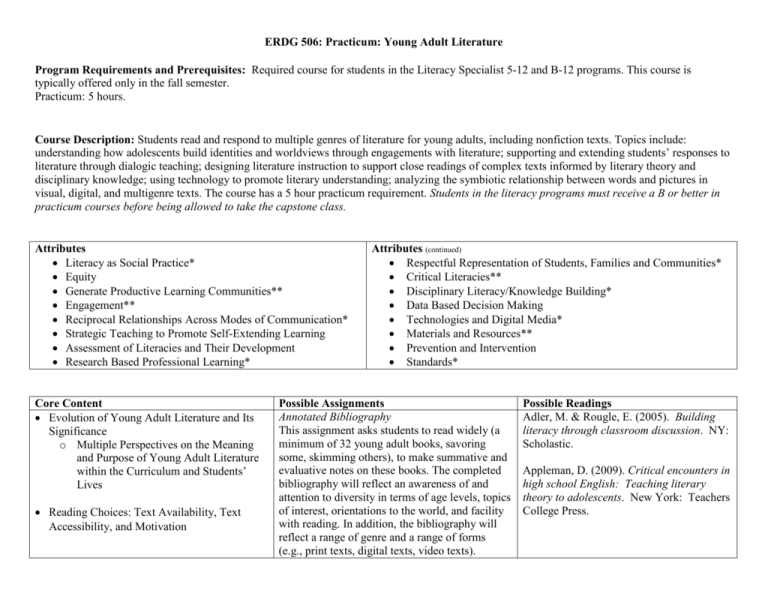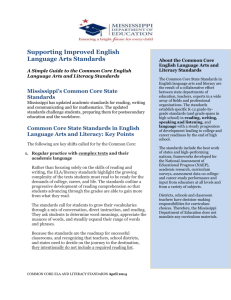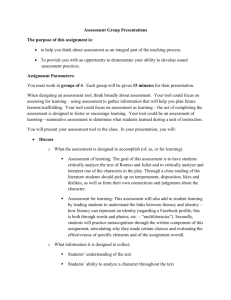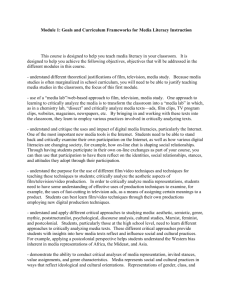ERDG 506 Practicum:Young Adult Literature
advertisement

ERDG 506: Practicum: Young Adult Literature Program Requirements and Prerequisites: Required course for students in the Literacy Specialist 5-12 and B-12 programs. This course is typically offered only in the fall semester. Practicum: 5 hours. Course Description: Students read and respond to multiple genres of literature for young adults, including nonfiction texts. Topics include: understanding how adolescents build identities and worldviews through engagements with literature; supporting and extending students’ responses to literature through dialogic teaching; designing literature instruction to support close readings of complex texts informed by literary theory and disciplinary knowledge; using technology to promote literary understanding; analyzing the symbiotic relationship between words and pictures in visual, digital, and multigenre texts. The course has a 5 hour practicum requirement. Students in the literacy programs must receive a B or better in practicum courses before being allowed to take the capstone class. Attributes Literacy as Social Practice* Equity Generate Productive Learning Communities** Engagement** Reciprocal Relationships Across Modes of Communication* Strategic Teaching to Promote Self-Extending Learning Assessment of Literacies and Their Development Research Based Professional Learning* Core Content Evolution of Young Adult Literature and Its Significance o Multiple Perspectives on the Meaning and Purpose of Young Adult Literature within the Curriculum and Students’ Lives Reading Choices: Text Availability, Text Accessibility, and Motivation Attributes (continued) Respectful Representation of Students, Families and Communities* Critical Literacies** Disciplinary Literacy/Knowledge Building* Data Based Decision Making Technologies and Digital Media* Materials and Resources** Prevention and Intervention Standards* Possible Assignments Annotated Bibliography This assignment asks students to read widely (a minimum of 32 young adult books, savoring some, skimming others), to make summative and evaluative notes on these books. The completed bibliography will reflect an awareness of and attention to diversity in terms of age levels, topics of interest, orientations to the world, and facility with reading. In addition, the bibliography will reflect a range of genre and a range of forms (e.g., print texts, digital texts, video texts). Possible Readings Adler, M. & Rougle, E. (2005). Building literacy through classroom discussion. NY: Scholastic. Appleman, D. (2009). Critical encounters in high school English: Teaching literary theory to adolescents. New York: Teachers College Press. Reading and Responding to Texts in a Digital Age Atwell, N. (2007). The reading zone: How to help kids become skilled, passionate, habitual, critical readers. New York: Scholastic. YA Library Visit and Report Students will investigate how adolescents and Building Knowledge of Formats and Genres of young adults are served by libraries in their schools and communities. Students will report on Young Adult Literature (including 1) the actual space; 2) the books available and Blackburn, M. (2003). Boys and literacies: explorations of picturebook, graphic novels, their marketing; and 3) programs and services What difference does gender make? poetry, nonfiction, realistic fiction, historical offered. Reading Research Quarterly, 38(2), 276fiction, fantasy, among others) 287. Young Adult Literature in the Content Areas Structuring Classroom Time to Encourage Independent Reading Designing Inquiries with Young Adult Literature to Explore Themes, Identities, and the Complexities of the Human Condition Reading and Engaging with “the Classics,” the Canon, and Complex Texts Common Core State Standards Individual Book Talk Each student prepares and presents to the class one brief book talk. Criteria for effective book talks will be developed jointly, based on discussions of particular assigned readings. Campbell, P. (2010). Campbell’s scoop: Reflections on young adult literature. Lanham, MD: Scarecrow Press, Inc. Group Mini-Inquiry Project Students work in small groups to read and discuss a common text and to develop a set of possible Cart, M. (2010): Young adult literature: mini-inquiries or explorations inspired by the From romance to realism. Chicago, IL: text. American Library Association. Book Challenges and Censorship Assessment and Young Adult Literature Blackburn, M, & Buckley, J.F. (2005). Teaching queer-inclusive language arts. Journal of Adolescent and Adult Literacy, 40(3), 202-212. Text-Set Project Students locate a minimum of ten thematically linked texts that could form the core of a multitext unit. Students articulate essential questions to guide the unit; provide a list of the texts accompanied by a short description of how each fits the focus; present a short list of possible miniinquiry opportunities with resources noted; and note connections to Common Core State Standards. Carter, J. B. (2005). Die a graphic death: Revisiting the death of genre with graphic novels, or “Why won’t you just die already?” The ALAN Review, 36(1), 15-25. Cole, P. (2009). Young adult literature in the 21st Century. Boston: McGraw-Hill. Dresang, E. (1999). Radical change: Books for youth in a digital age. New York: The H.W. Wilson Company. Frey, N. & Fisher, D. (Eds.). (2008). Teaching visual literacy. Thousand Oaks, CA: Corwin. Facilitating Online Book Engagements with Young Adults Within a supervised online setting monitored by the instructor, masters students engage high school students in talk around and about books, characters, issues, and ideas. This assignment is intended to help students 1) broaden and deepen their understandings of young adult readers, and 2) develop confidence and competence in facilitating open-ended discussions with a diverse group of young people around literature. Groenke, S. & Schaff, L (2010). Teaching young adult literature through differentiated instruction. Urbana, IL: NCTE. Harvey, S. & Daniels, H. (2009). Comprehension and collaboration. Portsmouth, NH: Heinemann. Herz, H. & Gallo, D. (2005). From Hinton to Hamlet: Building bridges between young adult literature and the classics, 2nd Ed. NY: Greenwood. Ivey, G. & Broaddus, K. (2000). Tailoring the fit: Reading instruction and middle school readers. The Reading Teacher, 54 (1), 68-78. Layne, S. (2009). Igniting a passion for reading: Strategies for building lifelong readers. Portland, ME: Stenhouse. Lesesne, T. (2010). Reading ladders: Leading students from where they are to where we’d like them to be. Portsmouth, NH: Heinemann. Jacobs, D. (2007). More than words; Comics as a means of teaching multiple literacies. English Journal, 69(3), 19-25. Lesesne, Teri (2004): Making the match: The right book for the right reader at the right time. Portland, ME: Stenhouse. Reeves, A. (2004). Adolescents talk about reading: Exploring resistance to and engagement with text. Newark, DE: IRA. Richison, J., Hernandez, A. & Carter, M. (2006). Theme-sets for secondary students. Portsmouth, NH: Heinemann. Robb, L. (2004). Teaching nonfiction: Writing from the inside out. NY: Scholastic. Schwartz, G. (2006). Expanding literacies through graphic novels. English Journal, 95(6), 58-64. Stallworth, B., Gibbons, L. & Fauber, L. (2006). It’s not on the list: An exploration of teachers’ perspectives on using multicultural literature. Journal of Adolescent and Adult Literacy, 49(6), 478489. Sturm, B. & Michel, K. (2009). The structure of power in young adult problem novels. Young Adult Library Services, Winter, 39-47. Xu, S., Perkins, R., & Zunich, L. (2005). Trading cards to comic strips: Popular culture texts and literacy learning in grades K-8. Newark, DE: IRA.











